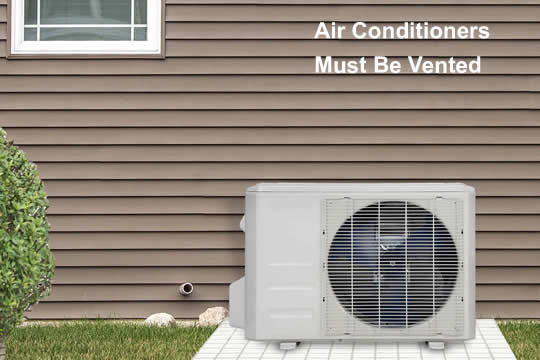Why Air Conditioners Are Vented
If you ever wanted to know why air conditioners are vented to the outside of a building, this tutorial will give you an understanding of how they work and why they work the way they do.
For many people living in air conditioned homes, whether they are small apartments or large houses and anything between, much of the inner workings of that box on the wall (or in the window) are an unknown.
 It's a simple case of something being out of sight and out of mind.
It's a simple case of something being out of sight and out of mind.
However, there are some things that it helps to know about the machine that keeps you cool in summer.
Where Does the Hot Air Go?
Perhaps the first question that comes to mind when thinking about air conditioning is where all the hot air from inside the house goes to.
In simple terms, the air conditioner draws in the warm air from inside the room and chills it by forcing it through what is called the evaporator coils. This is really just a network of thin tubes or pipes that are made very cold by a refrigerant medium that's circulating inside those tubes.
The Evaporator Coils
As the air meets the cold pipes, the heat it contains is locked up in tiny moisture droplets that condense on the pipes, effectively drying the air as it chills it. This cold air is then circulated back into the room.
If that was all that happened, an air conditioner would be a very simple machine indeed. But, as you probably already guessed, there is more to the story!
The Compressor
The refrigerant that circulates through the coils is a gas at normal sea level pressure (1g) but changes to a liquid when compressed. As the refrigerant becomes a liquid, it also cools down a lot.
The compressor in an air conditioner has the job of compressing the refrigerant from a warm gas to a very cold liquid. The liquid is then pumped around the coils to cool the air that is drawn in from the room.
Since the compressor is a mechanical device, it produces a lot of heat to get the job done.
So now we have hot air created by the compressor as well as the heat locked up in the condensed moisture from the air in the room. This needs to be removed separately from the cold air that is pumped back into the room.
This is achieved by sending the hot, moist air through a venting duct or pipe to the outside, where it simply disperses into the atmosphere.
The Condenser
With central and zoned (mini-split) air conditioning equipment, the venting off of the hot, moist air along with the air chilling side of things is done by an external unit that is located outside the building called the condenser.
This has a big fan that draws the hot, moist air from the internal cooling equipment through the ducts or vent pipes and expels it outside. It also condenses the moisture in the air from the room as it is chilled on the condenser coils, sending the cold air back inside to be distributed by the internal cooling split or central unit.
Window and Portable Air Conditioners
Window mounted and free standing, portable air conditioners don't have inside and outside units, since they do all the air conditioning process inside a single unit.
Window AC units are already mounted in a window frame and so the hot air is easily exhausted outside by vents located on the outward facing side of the unit.
Portable AC units need to be connected to a window or external wall vent via the flexible plastic hose that is connected to the back of the unit. This hose is used to vent the hot, moist air out of the room.
Ventless Air Conditioners
Then we have what is called a ventless portable air conditioner, no vent hose required.
The name is misleading, as all air conditioning equipment must be vented to allow the hot air produced by the compressor to be exhausted to the outside. If not, the air inside the room would rapidly heat up, instead of cooling down!
What is really meant by this term is a portable evaporative air cooler or swamp cooler.
These coolers do not have a compressor or refrigerant, but work by cooling the air by evaporation. A more detailed explanation of how these work can be found in my article on the pros and cons of evaporative coolers.
Conclusion
Essentially, all air conditioning equipment from central air and ductless mini-split to window and portable AC units relies on a form of venting or ductwork to allow the hot air produced by the mechanical equipment inside them to be vented out of the building.
Different configurations of air conditioning have differing ways of performing hot air extraction from the room being cooled, but the basic process is similar. By venting off the hot, moist air created by the refrigeration process, the air inside the room is chilled and dried, creating a comfortable atmosphere and pleasant temperature for the occupants.
Posted: May 18,2021
[Back to Top]